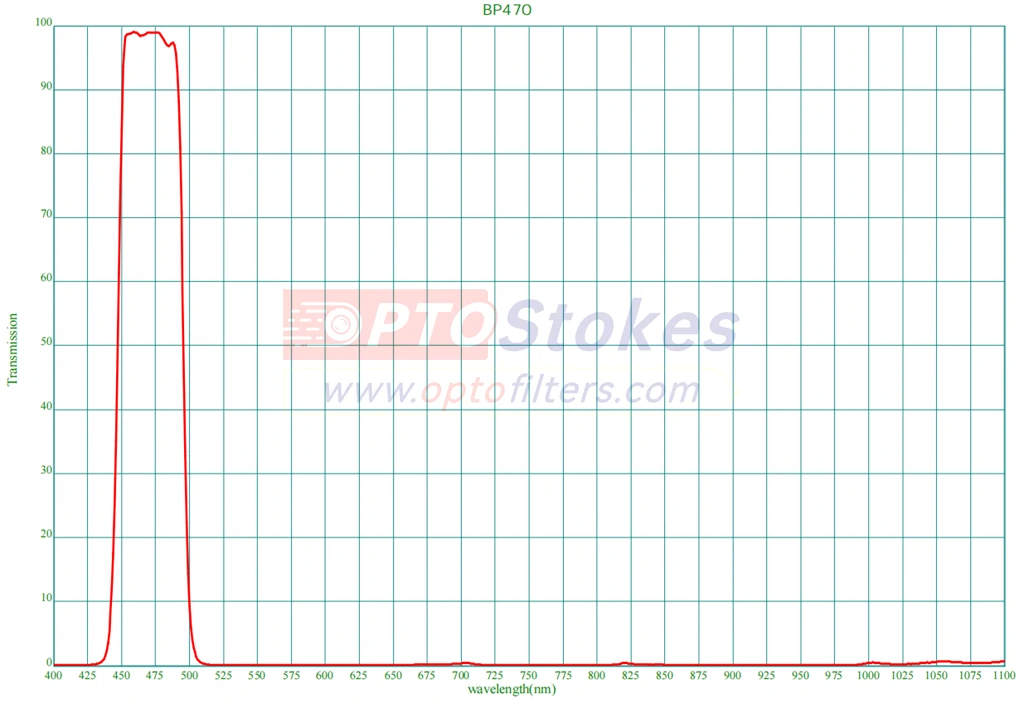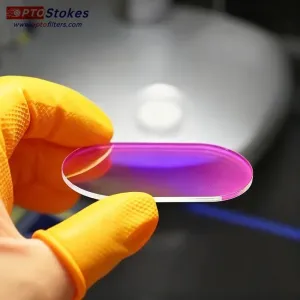BP470nm Bandpass Filter | FWHM 50nm, Thickness 1.0mm
The BP470-50nm-1.0mm bandpass filter is engineered for applications demanding maximum light throughput in the blue spectral region. Featuring a wide 50nm full width at half maximum (FWHM) centered at 470nm, this bandpass filter delivers exceptional photon collection efficiency for photon-starved detection scenarios, high-speed imaging applications, and broad-spectrum fluorescence measurements. The ultra-compact 1.0mm substrate thickness enables seamless integration into space-constrained optical systems while maintaining superior optical performance. Manufactured by OPTOStokes using advanced high precision coating technology, this filter provides the optimal balance between spectral selectivity and signal strength for demanding research and industrial applications.
Technical Specifications
The BP470-50nm-1.0mm filter features carefully optimized transmission characteristics that maximize signal collection while maintaining effective out-of-band rejection. The following table details the complete technical specifications:
| Parameter | Specification |
|---|---|
| Center Wavelength (CWL) | 470nm ± 5nm |
| Transmission Range | 450-490nm at T greater than 90% |
| Full Width at Half Maximum (FWHM) | 50nm ± 5nm |
| Blocking Range | 350-1100nm at T less than 1% |
| Substrate Thickness | 1.0mm |
| Surface Quality | 60/40 scratch-dig per MIL-PRF-13830B |
| Coating Type | Hard ion-assisted deposition |
| Part Number | 20224893 |
Key Performance Features
This blue bandpass filter distinguishes itself through a unique combination of wide spectral bandwidth and compact physical design. The 50nm FWHM provides significantly greater light collection efficiency compared to narrowband alternatives, making it ideal for applications where signal strength is paramount. Peak transmission exceeding 90% across the 450-490nm range ensures maximum photon throughput, critical for time-resolved measurements, high-frame-rate imaging, and weak signal detection.
The wide passband accommodates broad-spectrum light sources including blue LEDs with typical 20-30nm spectral widths, enabling efficient light utilization in illumination-critical applications. This characteristic also provides tolerance for LED wavelength variation across production batches and temperature-induced spectral shifts during operation. In fluorescence applications, the wider bandwidth captures more of the fluorophore emission spectrum, increasing detected signal levels and improving signal-to-noise ratios in photon-limited scenarios.
Despite the wide passband, the filter maintains exceptional out-of-band blocking with transmission below 1% from 350nm to 1100nm. This comprehensive rejection range eliminates UV autofluorescence, suppresses visible-range crosstalk, and blocks near-infrared interference, ensuring clean signal detection across diverse measurement conditions. The deep blocking performance protects sensitive detectors from saturation and enables accurate quantitative measurements in multi-wavelength systems.
The ultra-thin 1.0mm substrate thickness delivers critical advantages for modern optical instrument design. The compact profile minimizes optical path length, reducing focal shift and chromatic aberration in multi-element systems. The reduced thickness enables high-density filter packing in automated filter wheels and enables multiple filter positions within constrained axial spaces. Lower substrate mass facilitates faster switching speeds in motorized selection mechanisms and reduces mechanical bearing loads in precision positioning systems.
Applications
The BP470-50nm-1.0mm bandpass filter excels across applications where maximum light collection, spectral versatility, and compact integration are essential:
High-Throughput Fluorescence Screening: Drug discovery platforms, compound screening systems, and high-content imaging instruments require rapid data acquisition from multi-well plates and microfluidic devices. The BP470 filter's wide bandwidth maximizes photon collection from blue fluorophores including CFP, AmCyan, and Pacific Blue, enabling shorter exposure times and higher throughput. The increased signal strength allows lower excitation power, reducing phototoxicity in live-cell assays and photobleaching in fixed samples. Pharmaceutical research laboratories benefit from accelerated screening cycles and improved assay sensitivity.
Flow Cytometry and Cell Analysis: Modern flow cytometry systems analyze thousands of cells per second, requiring efficient fluorescence detection at high particle velocities. The wide bandpass characteristics capture maximum emission from blue-shifted fluorescent proteins and synthetic dyes, improving detection sensitivity for rare cell populations and dim markers. Clinical diagnostic applications including immunophenotyping, minimal residual disease monitoring, and stem cell enumeration rely on this filter's high collection efficiency for accurate cell quantification.
LED-Based Illumination Systems: Industrial machine vision, optical inspection, and photometric instrumentation increasingly utilize blue LED sources for their efficiency, longevity, and compact form factor. However, LED spectral output typically spans 25-40nm, requiring wider bandpass filters for efficient light utilization. The BP470 filter maximizes transmission of LED output while rejecting ambient lighting and unwanted wavelengths. Applications include surface defect detection, fluorescence-based quality control, photocatalyst evaluation, and photolithography alignment systems.
Widefield Fluorescence Microscopy: Traditional widefield microscopy systems prioritize imaging speed and field of view over spectral resolution, making wide bandpass filters ideal for emission collection. The BP470 filter efficiently captures blue fluorophore emissions while providing adequate spectral separation from green and red channels in multi-color imaging. Biological research applications including tissue histology, cellular localization studies, and developmental biology imaging benefit from the enhanced signal levels enabling faster acquisition and reduced photobleaching.
Environmental and Water Quality Monitoring: Field-deployable fluorescence sensors for water quality assessment, environmental monitoring, and process control applications utilize blue excitation for detecting organic compounds, petroleum hydrocarbons, and biological contaminants. The wide FWHM bandpass accommodates broad fluorescence emissions from complex environmental samples, while the compact 1.0mm profile enables integration into portable and handheld instrumentation.
Optogenetics and Photostimulation: Neuroscience research employing channelrhodopsin and other blue-light-activated proteins requires precise wavelength control for selective neuronal activation. The BP470 filter provides sufficient bandwidth to maximize stimulation efficiency from blue LED or laser sources while blocking wavelengths that could interfere with red-shifted calcium indicators or other fluorescent reporters used for simultaneous monitoring.
Customization and Engineering Solutions
OPTOStokes recognizes that advanced optical systems often require tailored solutions beyond standard catalog specifications. Our engineering team collaborates with customers to optimize filter designs for specific application requirements and integration constraints:
Spectral Customization: While the standard 50nm FWHM provides excellent light collection, bandwidth can be adjusted from 40nm to 70nm depending on application requirements. Narrower bandwidths improve spectral selectivity for multi-channel systems, while wider bandwidths further increase signal strength in photon-limited applications. Center wavelength can be tuned across the 460-480nm range to match specific LED sources, laser lines, or fluorophore emission peaks with ±1nm precision.
Dimensional Options: Standard circular formats are available in diameters from 12.5mm to 50mm, with square, rectangular, and custom geometries manufactured to fit proprietary optical assemblies. The 1.0mm thickness can be maintained for maximum compactness, or adjusted to 0.7mm for ultra-compact systems or 1.5mm/2.0mm for enhanced mechanical rigidity. Precision edge finishing including beveling, chamfering, and black edge coating options are available to minimize scattered light and facilitate mechanical mounting.
Mounting and Integration: Filters can be supplied unmounted for direct bonding and adhesive mounting, or pre-mounted in threaded retaining rings, drop-in cells, and filter cubes compatible with major microscope and instrumentation manufacturers. Custom mechanical interfaces accommodate legacy equipment retrofits and specialized instrumentation. Multi-filter assemblies combining this filter with complementary wavelength ranges can be supplied as integrated modules for simplified system assembly.
Environmental Specifications: Applications in demanding environments benefit from enhanced durability specifications including extended temperature ranges from -40°C to +85°C, high humidity resistance up to 95% relative humidity, and vibration tolerance meeting MIL-STD-810 standards. Hard coating formulations ensure durability under repeated cleaning cycles and harsh industrial conditions. UV-resistant edge coatings prevent degradation in high-UV environments.
Volume Production Support: OEM customers and instrument manufacturers benefit from our high-volume production capabilities, supply chain management, and quality assurance programs. Automated coating processes ensure batch-to-batch consistency across production runs spanning thousands of units. Vendor-managed inventory programs and consignment stocking arrangements ensure just-in-time availability while minimizing customer inventory carrying costs.
Why OPTOStokes for Wide Bandpass Filters?
OPTOStokes has established industry leadership in optical filter manufacturing through continuous innovation, quality excellence, and customer-focused service. Our extensive inventory of standard bandpass filters ensures immediate availability for urgent requirements, with most configurations shipping within 24-48 hours of order confirmation. This rapid response capability eliminates project delays and accelerates time-to-market for instrument development programs.
Our manufacturing expertise in








